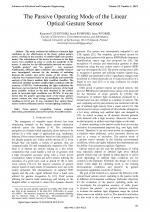| 1/2018 - 18 | View TOC | « Previous Article | Next Article » |
The Passive Operating Mode of the Linear Optical Gesture SensorCZUSZYNSKI, K. |
| Extra paper information in |
| Click to see author's profile in |
| Download PDF |
Author keywords
gesture recognition, human computer interaction, photodiodes, interactive system, wearable sensors
References keywords
gesture(26), sensor(15), recognition(12), sensors(6), ruminski(6), interaction(6), devices(6), czuszynski(6), comput(6), wtorek(5)
Blue keywords are present in both the references section and the paper title.
About this article
Date of Publication: 2018-02-28
Volume 18, Issue 1, Year 2018, On page(s): 145 - 156
ISSN: 1582-7445, e-ISSN: 1844-7600
Digital Object Identifier: 10.4316/AECE.2018.01018
Web of Science Accession Number: 000426449500018
SCOPUS ID: 85043282873
Abstract
The study evaluates the influence of natural light conditions on the effectiveness of the linear optical gesture sensor, working in the presence of ambient light only (passive mode). The orientations of the device in reference to the light source were modified in order to verify the sensitivity of the sensor. A criterion for the differentiation between two states - possible gesture and no gesture - was proposed. Additionally, different light conditions and possible features were investigated, relevant for the decision of switching between the passive and active modes of the device. The criterion was evaluated based on the specificity and sensitivity analysis of the binary ambient light condition classifier. The elaborated classifier predicts ambient light conditions with the accuracy of 85.15%. Understanding the light conditions, the hand pose can be detected. The achieved accuracy of the hand poses classifier trained on the data obtained in the passive mode in favorable light conditions was 98.76%. It was also shown that the passive operating mode of the linear gesture sensor reduces the total energy consumption by 93.34%, resulting in 0.132mA. It was concluded that optical linear sensor could be efficiently used in various lighting conditions. |
| References | | | Cited By |
Web of Science® Times Cited: 6 [View]
View record in Web of Science® [View]
View Related Records® [View]
Updated today
SCOPUS® Times Cited: 6
View record in SCOPUS® [Free preview]
View citations in SCOPUS® [Free preview]
[1] Gesture Recognition With the Linear Optical Sensor and Recurrent Neural Networks, Czuszynski, Krzysztof, Ruminski, Jacek, Kwasniewska, Alicja, IEEE Sensors Journal, ISSN 1530-437X, Issue 13, Volume 18, 2018.
Digital Object Identifier: 10.1109/JSEN.2018.2834968 [CrossRef]
[2] The intelligent vehicle target recognition algorithm based on target infrared features combined with lidar, Zhang, Wanyi, Fu, Xiuhua, Li, Wei, Computer Communications, ISSN 0140-3664, Issue , 2020.
Digital Object Identifier: 10.1016/j.comcom.2020.03.013 [CrossRef]
[3] A novel crosstalk-free piezoresistive/self-capacitive bimodal sensor for human-robot collaboration, Liu, Zhe, Chen, Diansheng, Ma, Junlin, Wang, Xinchi, Wang, Tingyu, Jia, Daiyu, Liu, Yutong, Sensors and Actuators A: Physical, ISSN 0924-4247, Issue , 2024.
Digital Object Identifier: 10.1016/j.sna.2023.114910 [CrossRef]
[4] Towards Contactless, Hand Gestures-Based Control of Devices, Czuszynski, Krzysztof, Ruminski, Jacek, IECON 2018 - 44th Annual Conference of the IEEE Industrial Electronics Society, ISBN 978-1-5090-6684-1, 2018.
Digital Object Identifier: 10.1109/IECON.2018.8591446 [CrossRef]
[5] Digits Recognition with Quadrant Photodiode and Convolutional Neural Network, Janczyk, Kamil, Czuszynski, Krzysztof, Ruminski, Jacek, 2018 11th International Conference on Human System Interaction (HSI), ISBN 978-1-5386-5024-0, 2018.
Digital Object Identifier: 10.1109/HSI.2018.8431246 [CrossRef]
Disclaimer: All information displayed above was retrieved by using remote connections to respective databases. For the best user experience, we update all data by using background processes, and use caches in order to reduce the load on the servers we retrieve the information from. As we have no control on the availability of the database servers and sometimes the Internet connectivity may be affected, we do not guarantee the information is correct or complete. For the most accurate data, please always consult the database sites directly. Some external links require authentication or an institutional subscription.
Web of Science® is a registered trademark of Clarivate Analytics, Scopus® is a registered trademark of Elsevier B.V., other product names, company names, brand names, trademarks and logos are the property of their respective owners.
Faculty of Electrical Engineering and Computer Science
Stefan cel Mare University of Suceava, Romania
All rights reserved: Advances in Electrical and Computer Engineering is a registered trademark of the Stefan cel Mare University of Suceava. No part of this publication may be reproduced, stored in a retrieval system, photocopied, recorded or archived, without the written permission from the Editor. When authors submit their papers for publication, they agree that the copyright for their article be transferred to the Faculty of Electrical Engineering and Computer Science, Stefan cel Mare University of Suceava, Romania, if and only if the articles are accepted for publication. The copyright covers the exclusive rights to reproduce and distribute the article, including reprints and translations.
Permission for other use: The copyright owner's consent does not extend to copying for general distribution, for promotion, for creating new works, or for resale. Specific written permission must be obtained from the Editor for such copying. Direct linking to files hosted on this website is strictly prohibited.
Disclaimer: Whilst every effort is made by the publishers and editorial board to see that no inaccurate or misleading data, opinions or statements appear in this journal, they wish to make it clear that all information and opinions formulated in the articles, as well as linguistic accuracy, are the sole responsibility of the author.



